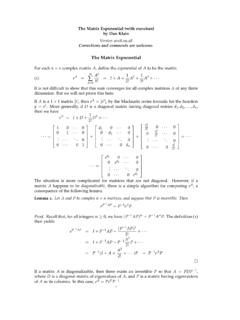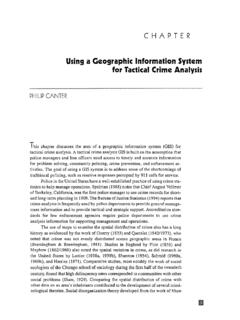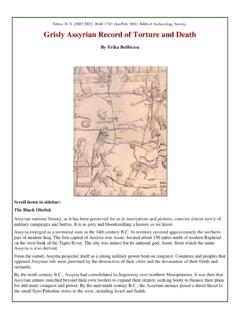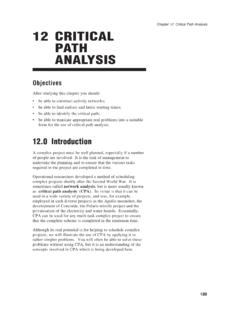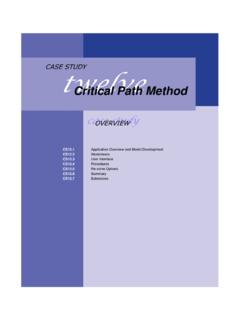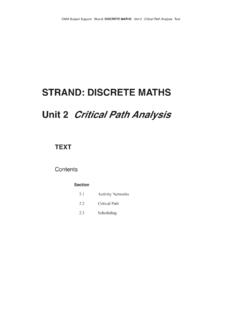Transcription of Program Evaluation and Review Technique (PERT) and ...
1 Program Evaluation and Review Technique (PERT) and critical path Method (CPM) Applications Two simple, yet interesting and important applications of partial ordering relations are the PERT and CPM techniques in job scheduling. See exercise 50 in the text, section for an example of the list of tasks needed to build a house. If we let A = {set of tasks given in exercise 50} and define the relation R on A by : xRy iff task x precedes (is a prerequisite task of) task y or task x = task y the Hasse diagram is as is given in the illustration in the text. We now expand on this, and the above techniques through several examples: Note in the following examples read the diagrams from left to right. Example 2. The construction of a cottage requires the performance of certain tasks. The following table 1 lists the various tasks with their priority relationship. The start task ( ) and finish task ( ) are added, is linked to task A and is linked to task K.
2 Table 1 Code Of Task Duration (Weeks) Prerequisite tasks A Masonry 7 - B Carpentry for roof 3 A C Roof 1 B D Sanitary and electrical installations 8 A E Front 2 D, C F Windows 1 D, C G Garden 1 D, C H Ceiling 3 F J Painting 2 H K Moving in 1 E, G, J Finish Start 2 2 2 1 0 1 1 1 1 8 8 8 7 7 3 1 Let S be the set of all tasks and consider the partial order relation R defined on S as follows: for all tasks x and y in S, xRy x = y or x precedes y. The minimum time required to finish this job is calculated using Project Evaluation and Review Technique (PERT). The PERT diagram of the project is shown in the figure 1. Figure 1 In this representation, the tasks are the vertices of the graph. The length of each task is the duration of the corresponding task.
3 The start and finish of a task are two stages of the project. We can define an initial stage as start and a final stage as finish and a certain number of intermediate stages. Each stage is defined by tasks already carried out. In the beginning milestone of the project is start stage. The start followed by task A which is carried out in 7 weeks. After finishing stage A, we have two options. We can start task B and task D simultaneously. Task B takes 3 weeks to finish and task D takes 8 A D F J H E K G C B weeks to finish the job. Task B is immediately followed by task C, which takes one week to carry out. The minimum time required to start task C is the total time required to finish task B and A which is 10 weeks. Task C is followed by task E. to start task E, we have to finish C and D. C is finished in 11 weeks, and D is finished in 15 weeks, so it is very common that we cannot start task E before finishing task D which takes 15 weeks to carry out.
4 Same way, we can decide the earliest time to start each task, which is shown in Table 2. below: Table 2 Task Earliest Start Time Start ( ) 0 A 0 B 7 C 10 D 7 E 15 F 15 G 15 H 16 J 18 K 20 Finish ( ) 21 The above analysis shows that at least 21 weeks is required to complete the project. The minimum duration of the project will be the length of the longest path between the initial stage and the finish stage. This is shown in with the darker line in the figure 2. Finish Start 0 8 7 3 1 2 1 2 8 2 1 8 1 1 1 (0) (0) (21) (7) (7) (10) (15) (15) (15) (16) (18) (20) Figure 2 If we delay any work in this path , we delay in the project finish time. That means delay in performing any of these tasks in the path cause delay in the time required to finish the project, and for these reason, this path is known as critical path . The tasks outside the critical path can be delayed by certain amount of time.
5 For example task E is not on critical path and it is followed by task K. If we delay E by 3 week than its earliest start time, then we can start the task K as per its earliest start time because K must be started after finishing J which takes 20 weeks. We can finish task E in 20 weeks by delaying 3 weeks. In the opposition if we delay work on the critical path , we delay the time to complete the project. For example 3 weeks delay in task J cause 3 weeks delay to start K, and K start after 3 weeks than its earliest start time and these cause three week delay to complete the project. Now if we finish task J earlier by one A B D F E K G C H J week then we can also reach task K earlier by one week and finish it off. And finally the overall project is also finished one week before. Example 3. In order to construct a house, there are many jobs that need to be done at the same time.
6 Certain parts of the construction must be done before others can be started. We can not start wiring the house if the walls have not been put up, and we can not put the walls up till the foundation had been set. Before the foundation is set, you must choose a good plot to dig the foundation hole. However, there are certain jobs which can be done simultaneously. While you are wiring the outlets, you can have someone do the heating and air conditioning ducts or can have the landscaper working on the outside layout. The partial order diagram will allow one to see how long the whole process will take. Below, we show each task that needs to be done, and the amount of time required for that task. The amount of time is estimated. 1. Find Plot 2 days 2. 1 Excavate land 5 days 3.
7 Dig for foundation 3 days 4. Lay concrete foundation 5 days 5. Exterior firework 2 days 6. Exterior electrical 2 days 7. Exterior gasline 5 days 8. Supports for walls/ceiling/floor/stairs 5 days 9. Siding/Roof 3 days 10. Windows 1 days 11. Interior wiring 2 days 12. Interior plumbing 2 days 13. Heating/AC ducts 2 days 14. Insulation 1 day 15. Dry wall 2 days 16. Landscaping 14 days 17. Painting 2 days 18. Light Fixtures/Switches 7 hours 19. Floor Ring 2 day 20. Doors/Cabinets 1 day 21. Clean-up 1 day The next table shows what task precedes each task. This allows us to see what tasks can be done at the same time.
8 If one task does not depend on the other, then those two tasks can be done at the same time. Task Percent Tasks Time 1 0 2 days 2 1 5 days 3 2 3 days 4 3 5 days 5 1,2,3,4 2 days 6 1,2,3,4 2 days 7 1,2,3,4 2 days 8 4 5 days 9 8 3 day 10 8 1 day 11 8 2 days 12 8 2 days 13 8 2 days 14 10,11,12,13 1 day 15 14 2 days 16 8 14 days 17 15 2 days 18 17 7 hours 19 17 2 days 20 19 1 day 21 20 1 day Partial Order formula: x R y x = y or x precedes y We read the following Hasse diagram from left to right to find the minimum time for the whole process of constructing the house. Partial Order Diagram: Construction of a House critical path Method(CPM): 1,2,3,4,816,21 which is 35 days The critical path time can be reduced if we do certain tasks differently. The time for landscaping right now is 14 days.
9 But if more workers are used, then the time will be less. If pre-fabricated materials are used, then it will take less time, because less people are needed, and less time is used in making the material. Also depending on the design Task 12 DaysTask 2 5 DaysTask 3 3 DaysTask 4 5 DaysTask 6 2 DaysTask 7 2 DaysTask 8 5 DaysTask 5 2 DaysTask 12 Task 11 Task 10 Task 13 Task 16 Task 9 3 DaysTask 14 Task 15 Task 17 of the house, the time can be reduced or even increased. If less rooms are needed by the family that is living there, then it will take less time, then designing at large size home with many rooms, and closets inside each room. What can also reduce the time is experience of the construction workers. If the workers are new, then they will be a bit slower, and making more mistakes which increases the time for each task.
10 Example 4. A student example. Are the partial ordering diagrams complete? Can you fill in the missing edges? As an application of partial order relations, I have chosen to refurbish my younger daughter s bedroom. This is a project that I am actually in the middle of now, but I decided to see how fast it would get done if I were commanding a number of professionals. Let A={tasks}. We can define R on A by xRy iff {x=y or task x is a prerequisite of task y}. The job can be divided into several tasks: 1. Move all of my daughters things out. 2. Rip out doorjam from bedroom to bathroom (the bathroom is to become a master bath). 3. Lower two electrical outlets, sheetrock holes (previous owners had a two family with this room as a kitchen so two outlets are above where the counter used to be). 4. Frame doorway, install electrical outlet, send wires up into attic, and sheetrock over doorway to bath.



